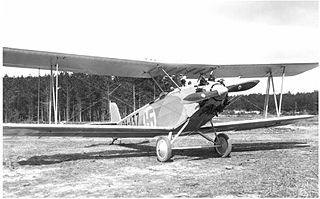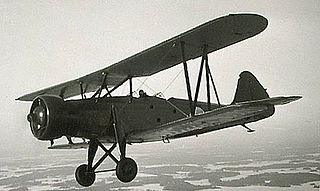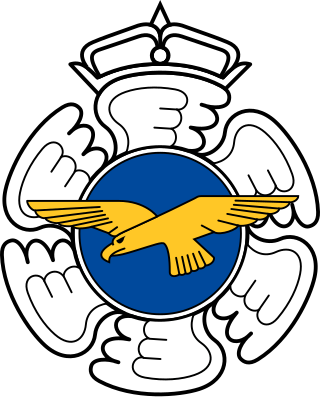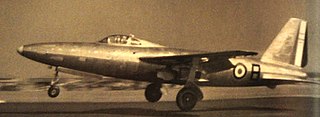
The Republic XF-91 Thunderceptor is a mixed-propulsion prototype interceptor aircraft, developed by Republic Aviation. The aircraft would use a jet engine for most flight, and a cluster of four small rocket engines for added thrust during climb and interception. The design was largely obsolete by the time it was completed due to the rapidly increasing performance of contemporary jet engines, and only two prototypes were built. One of these was the first American fighter to exceed Mach 1 in level flight.

The Kharkiv KhAI-5, was a Soviet reconnaissance and light bomber aircraft, designed in the mid-1930s in the Kharkiv Aviation Institute, under the direction of Iosif Grigorevich Nyeman.

The Valmet L-70 Vinka is a Finnish-designed piston-powered military basic trainer aircraft of the 1970s. A production run of 30 aircraft were built for the Finnish Air Force in the early 1980s, and although the type was not exported, it formed the basis of the turboprop-powered Aermacchi M-290 RediGO.

The VL Humu (Whirlwind) is a Finnish fighter aircraft, designed by Valtion lentokonetehdas in 1944, and based on the American Brewster F2A Buffalo.

The VL Myrsky ("Storm") is a Finnish World War II fighter aircraft originally developed by Valtion lentokonetehdas for the Finnish Air Force. The models of the aircraft were Myrsky I, Myrsky II, and Myrsky III.

The VL Pyörremyrsky ("Hurricane") was a Finnish fighter, designed by DI Torsti Verkkola at the State Aircraft Factory for service with the Finnish Air Force in World War II. The war ended before the type's first flight and only a prototype was built.

VL Paarma was a Finnish biplane, two-seat trainer aircraft, designed by the State Aircraft Factory for use with the Finnish Air Force.

The VL Tuisku was a Finnish trainer aircraft designed in the 1930s. It was a two-seat, single-engined biplane with a welded steel framework, covered with fabric. 30 were produced for the Finnish Air Force and served from 1935 to 1949.

VL Viima, constructed by the State Aircraft Factory is a Finnish two-seat, biplane trainer used by the Finnish Air Force from the late 1930s to the early 1960s. After military service, several were released into civil use.

Valmet Vihuri was a Finnish advanced two-seat fighter trainer aircraft, serving in the Finnish Air Force between 1953 and 1959. Only a few airframes have survived, as in the Central Finland Aviation Museum in Finland.

The Valmet Tuuli was a trainer aircraft, developed for the Finnish Air Force by the State Aircraft Factory. The aircraft was to be produced in 3 different versions. The last version, Tuuli III was redesigned from scratch, and is basically an entirely different aircraft.

Koolhoven F.K.52 was a Dutch-designed, two-seat reconnaissance-fighter biplane, which was developed in the 1930s by Koolhoven. The aircraft was equipped with an enclosed cockpit and single-strut landing gear. Only six aircraft were produced. The aircraft saw some service in the Finnish Air Force.

The Grigorovich M-9 was a Russian World War I-era biplane flying boat, developed from the M-5 by Grigorovich.

The Finnish Air Force Museum, formerly the Aviation Museum of Central Finland, is an aviation museum located near Jyväskylä Airport in Tikkakoski, Jyväskylä, Finland. The museum exhibits the aviation history of Finland, from the early 1900s until today. The museum is owned by the Foundation of Aviation Museum of Central Finland.

The Hannover CL.III was a German military aircraft of World War I. It was a two-seat multi-role aircraft, primarily used as a ground attack machine. Like the other Hannover "light-C-class", or "CL" designated aircraft designed by Hermann Dorner, it included an unusual biplane tail, allowing for a greater firing arc for the tail gunner. Until the introduction of the aircraft, such tails had only been used on larger aircraft.

The Heinkel HD 37 was a fighter aircraft, designed in Germany in the late 1920s, but produced in the USSR for Soviet Air Force service. It was a compact, single-bay biplane with staggered wings of unequal span, braced by N-type interplane struts. The pilot sat in an open cockpit, and the main units of the tailskid undercarriage were linked by a cross-axle.

The Kalinin K-4 was an airliner built in the Soviet Union in the late 1920s which was also adapted for use as a photographic survey aircraft and as an air ambulance. A further development of the K-1, it was a conventional high-wing, strut-braced monoplane with separate enclosed cabin and cockpit. Kalinin undertook the design to offer a locally produced alternative to pioneering Ukrainian airline Ukrvozdukhput, which was at that time flying Dornier designs. The structure was of mixed wood and metal construction, but with major assemblies designed in both wood and metal versions, allowing them to be interchanged. The design also featured a variable-incidence horizontal stabiliser, and the engine mounting was intended to facilitate the ready interchange of different powerplants.

The Training Air Wing was the Finnish Air Force pilot jet aircraft training school. It is located at Kauhava Airport in Kauhava, in Southern Ostrobothnia. The unit trains pilots for the Finnish Defence Forces, as well as for the Finnish Border Guard.

The Air Force Academy is located at Tikkakoski in Jyväskylä, Finland. The primary mission of the Air Force Academy is to train warfighting airmen who can carry out their missions even under most strenuous conditions. This includes conscripts and active duty personnel and special forces such as pilots, aircraft and helicopter mechanics, and air surveillance controllers. The Air Force Academy also trains conscripts for general military operations. While training is primarily geared to serve air base functions, a number of conscripts are trained for jobs in the control and reporting centres. The Air Force Academy comprises a headquarters and a Communication Systems Training Flight, Aircraft and Weapon Systems Training Flight, Reserve Non-Commissioned Officer Training School, and a Reserve Officer Training School.

The Sud-Ouest SO.6020 Espadon (Swordfish) was a French post-war prototype interceptor designed and built by SNCASO during the late 1940s. The French Air Force judged the design a failure despite some records being set and cancelled plans to put it into service in 1951. Only four aircraft were built and they were later modified to serve as testbeds for the mixed rocket and turbojet-powered SNCASO SO.9000 Trident program. Only one badly damaged aircraft survives.



















